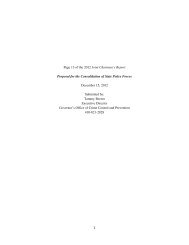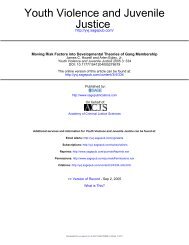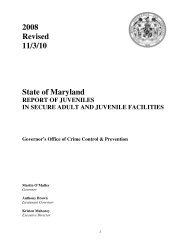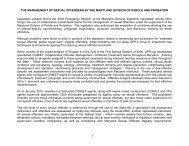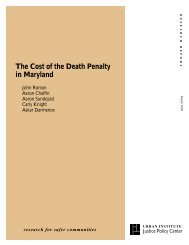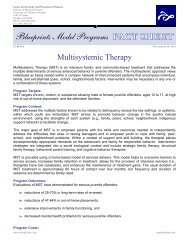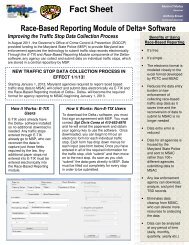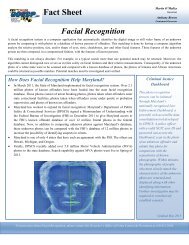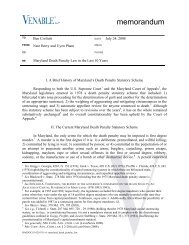Targeted Outreach - Governor's Office of Crime Control & Prevention ...
Targeted Outreach - Governor's Office of Crime Control & Prevention ...
Targeted Outreach - Governor's Office of Crime Control & Prevention ...
You also want an ePaper? Increase the reach of your titles
YUMPU automatically turns print PDFs into web optimized ePapers that Google loves.
54 <strong>Targeted</strong> <strong>Outreach</strong><br />
The Getting Out program focuses heavily, although not<br />
exclusively, on Asian gangs as a result <strong>of</strong> the location <strong>of</strong><br />
the Clubs participating in the initiative. Clubs are located<br />
in and around a large Hmong community. The unique<br />
issues in this community, resulting from their immigrant<br />
experience, appeared to contribute to the gang problem.<br />
In particular, family dynamics had changed as a result <strong>of</strong><br />
immigration. Youth have developed greater language<br />
skills and familiarity with American culture than have<br />
their parents and, as a result, have more power in the<br />
family. But conversely, youth are left feeling more vulnerable.<br />
Reports indicated that Asian youth are <strong>of</strong>ten picked<br />
on in school because <strong>of</strong> language and cultural differences,<br />
so they join gangs as a way <strong>of</strong> protecting themselves. St.<br />
Paul developed a gang task force that works closely with<br />
the Boys & Girls Clubs, and the school system adopted a<br />
policy <strong>of</strong> zero tolerance for gang-related behaviors.<br />
History and Development <strong>of</strong> Getting Out<br />
The St. Paul Gang Task Force and BGCA approached the<br />
St. Paul Boys & Girls Club about beginning a program for<br />
gang-involved youth. For some time, the Gang Task Force<br />
and local social service agencies who work with ganginvolved<br />
youth had recognized the need for a tattoo<br />
removal service. Because <strong>of</strong> the expense, however, no<br />
agency in St. Paul had been able to provide it. The<br />
Minneapolis Boys and Girls Club had temporarily <strong>of</strong>fered<br />
the service but was forced to discontinue it.<br />
When the idea was initially proposed, staff at the St. Paul<br />
Club were reluctant to become involved. The project asked<br />
Club staff to reach out to a higher-risk population <strong>of</strong> youth<br />
than they were used to serving. Eventually they became<br />
more comfortable with the idea and began to develop the<br />
program. Staff at the Club worked closely with the Gang<br />
Task Force who, along with BCGA, provided the initial<br />
funding. The Gang Task Force also identified a plastic surgeon<br />
who was willing to do pro bono tattoo removal once<br />
a month. Once these services were in place, a coordinator<br />
was hired and the program began to receive referrals<br />
immediately.<br />
Referral, Recruitment and Target Population<br />
Youth are referred to the program by schools, police, probation,<br />
community agencies or Boys and Girls Club staff or<br />
parents. Youth may also find out about the program by<br />
word <strong>of</strong> mouth and may initiate contact on their own. One<br />
successful outreach strategy has been for staff to go to<br />
schools during lunch to meet and recruit youth. <strong>Outreach</strong><br />
staff have also attempted to recruit at the Clubs by making<br />
evening visits to make contact with gang youth.<br />
Through experience, the target population for the program<br />
has been refined to focus on youth who want to<br />
leave the gang. The Club made a decision to focus on this<br />
population because they felt that youth who were not<br />
ready to make a change demanded too much <strong>of</strong> the staff’s<br />
time. Because the program is providing free tattoo<br />
removal, they felt it important to reserve this service for<br />
those youth that were ready to leave the gang. This is an<br />
important stipulation because some youth may want a tattoo<br />
removed so they can switch gangs. Their referral<br />
sources are aware <strong>of</strong> this policy.<br />
Intake and Tracking<br />
Once the youth are informed about the program, the<br />
referring adult contacts the Getting Out staff to arrange<br />
for someone to come and speak to the youth. The staff<br />
member describes the program and attempts to engage<br />
the youth’s interests during a 20- to 30-minute interview.<br />
They then provide the youth with next steps, i.e., a phone<br />
number to call for follow-up. They require that the youth<br />
take the initiative to call the staff for an appointment. The<br />
youth are then expected to complete their first month <strong>of</strong><br />
community service before they can begin tattoo removal.<br />
The intake meeting is usually held with the parents, and a<br />
case history, medical information, goals and interests are<br />
obtained. In addition, a pre-screening questionnaire is<br />
given to youth during the interview process to help assess<br />
their level <strong>of</strong> motivation for changing their lifestyle.<br />
In addition to the information on the standard tracking<br />
forms used by all the sites, Getting Out staff keep logs <strong>of</strong><br />
conversations, phone calls and the goal-setting activities<br />
they do with the youth.<br />
Project Staffing<br />
Initially, the project had significant staff turnover—three<br />
coordinators in the first year. In February 1998, five new<br />
staff members were hired, including a new program coordinator.<br />
The program expanded its staff at this point to six<br />
full-time employees. The program coordinator is responsible<br />
for overseeing all program operations including<br />
staffing and budgeting. She also served as a case manager<br />
for a few <strong>of</strong> the participants. The program coordinator<br />
reported to the Club’s director <strong>of</strong> operations. The remaining<br />
five staff were outreach coordinators, the primary case<br />
managers. They also arranged community service assignments,<br />
networked with community agencies and organized<br />
parent outreach. One outreach coordinator served as the<br />
primary contact for police and parole <strong>of</strong>ficers.<br />
Changes to the Club<br />
According to staff, no specific changes had been made to<br />
the Club facility to accommodate the Getting Out program.<br />
Fire code requirements prevented the addition <strong>of</strong><br />
security to the building, such as locking additional<br />
entrances. There were changes, however, in policies and



